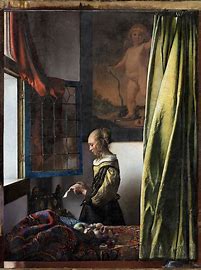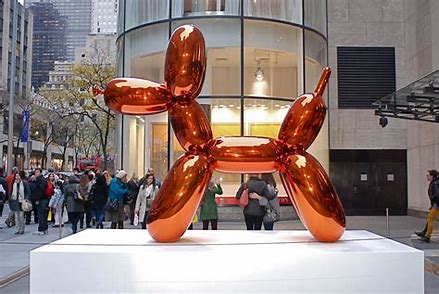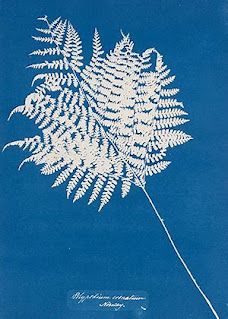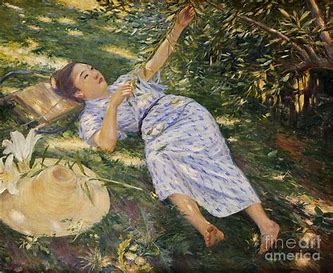Baroque Blog
In my baroque blog, I would like to introduce you to Johannes Vermeer's Girl Reading a Letter at the Open Window (1657-1659), which is an 83x64.5 cm (32 3/4x 25 3/8 inches) oil on canvas painting that is displayed at Gemäldegalerie Alte Meister (Old Masters Picture Gallery), Dresden, Germany. The painting depicts a young blonde woman standing in profile at an open window and reading a letter. The heavy red curtain is draped over the top of the window, which opens to the inside of the room and reflects the girl in the windowpane. Another heavy green satin drapery falls before the painted scene, a perfect example of trompe l'œil. "In real Dutch households, this kind of curtain was employed to protect precious paintings from dust or for covering nudes. The trompe l'œil curtain was also a favorite illusionist trick among painters of the Delft School." (Jason,2024)

The oriental rug, carelessly draped over the table, creates rich folds and upends the bowl of fruit that spills over, framing the lower part of the painting. The composition of the painting is brimming with rectangular forms, as seen in the windowpane, open window frame, portrait behind the girl (about that later), and the table. The open wall spaces create rectangular forms as well.
The light source comes from the open window and touches the woman's face, green left corner-out-of-room drapery, letters, and the fruit. The light falls diagonally through the canvas, reaching the green drapery and cascading over the woman's face, hands, letter, and fruits.
The painting is rich in curtains that frame the scene in the painting's left, right, and lower parts. Vermeer's masterful execution of draperies in his paintings can probably be attributed to his upbringing. "His father, Reynier Vermeer, was a silk weaver who produced caffa, a fine satin fabric, but in 1631 he also registered in the Saint Luke’s Guild in Delft as a master art dealer." (Arthur, n.d.)
The Lady with a Letter at the Open Window is a secular painting depicting a quiet moment in the life of a young woman engrossed in a letter that places the viewer into the position of a secret voyeur. The rising economic development of the Netherlands enabled painters to deviate from religious subjects in art. Portraits and scenes from daily life became desirable and even more so affordable since the rise of the merchant classes. "The rich middle class had disposable income and collecting paintings –especially still life- was a good way to establish a high position in society as a connoisseur, showcasing their good taste and showing off their wealth." (Rekkali, 2016)
The painting is full of hidden clues that might be seen as one of the tongue-in-cheek or hunting-for-clues paintings of Johannes Vermeer. The painting of Cupid in the background was recently discovered. "The Gallery of Old Masters in Dresden recently revealed the painting following years of restoration. The famous Vermeer's work has been cleared up and a new detail, a painting of Cupid, has appeared on the wall just above the girl. In addition, a segment just below the green curtain reveals the base of a mysterious wine glass or a Dutch roemer." (Anapur, 2021)
The artwork introduces the viewer to the ultimate moment of a plausible love story, with the Cupid painting being the most visible clue of the romantic nature of the letter. The spilled fruit, apples, and peaches are clues as well, with the apple connected to Eve's sinfulness. While the peach "...the artists of Renaissance symbolically used peach to represent the heart..."(Rekkali, 2016) was used by J. Vermeer in the same tradition. However, after closer observation, the letter in the girl's hands does not display any words; it is empty. The artist once again left it to the viewer's imagination to create the content of the written message.
The painting is unique in terms of an unrivaled and successful attempt at intimate visual experience and artist-public communication. The unmediated atmosphere of the painting allows us to feel present in this fleeting moment of a girl's life, peeking from behind the curtain, waiting for her to lower her hands and turn her head to the audience with a shy smile or exclaim of surprise.
No, I would not like to own a copy of this masterpiece for the same reason I would not like a copy of the painting Lady with an Ermine.
Resources Cited
Anapur, Eli. “A Hidden Image Revealed behind Vermeer’s Girl Reading a Letter at an Open Window.” Widewalls, 3 Sept. 2021, www.widewalls.ch/magazine/vermeer-girl-reading-letter-dresden.
Arthur K. Wheelock Jr., “Johannes Vermeer,” NGA Online Editions, https://purl.org/nga/collection/constituent/1951 (accessed February 24, 2024).
Janson, Jonathan. "The Complete Interactive Vermeer Catalogue." GIRL READING A LETTER BY AN OPEN WINDOW by Johannes Vermeer, 9 Jan. 2024, www.essentialvermeer.com/catalogue/girl_reading_a_letter_by_an_open_window.html#top.
Rekkali, Zeynep. “Decoding the Hidden Meanings in Still Life Painting - What Is It Worth?” What Is It Worth? - An Insider Look at the Art, Antiques and Collectibles Market., 11 Aug. 2016, blog.mearto.com/2016/08/11/decoding-the-hidden-meanings-in-still-life-painting/.



I really like this painting. The soft, subdued lighting coming through the window of a young woman reading a personal letter in a secluded setting. I can easily picture her tucking it away to a safe place until she can read it again in private. The painting of Cupid above adds even more of a romantic feel to it.
ReplyDeleteMany of the paintings from this period I do not like due to the display of violence or nudity, so it is refreshing to see one such as this.
Thank you for such an enriching analysis of this painting! your insight and context makes the painting even more interesting, I am particularly fascinated by the relationship between the viewer and the narrative of the painting. The allusions to a love story seen in the cupid and the letter are strong, but the lack of writing in the letter and its implications that we as a viewer can come up with our own story is very interesting. The pulled back green curtain certainly feels as though it was drawn so we can get a glimpse into the moment unfolding. These two together make me as a viewer feel like apart of the love story unfolding, as though I am poised to find out the crux of my love interest. I certainly love this painting so thank you for sharing your insight!
ReplyDelete